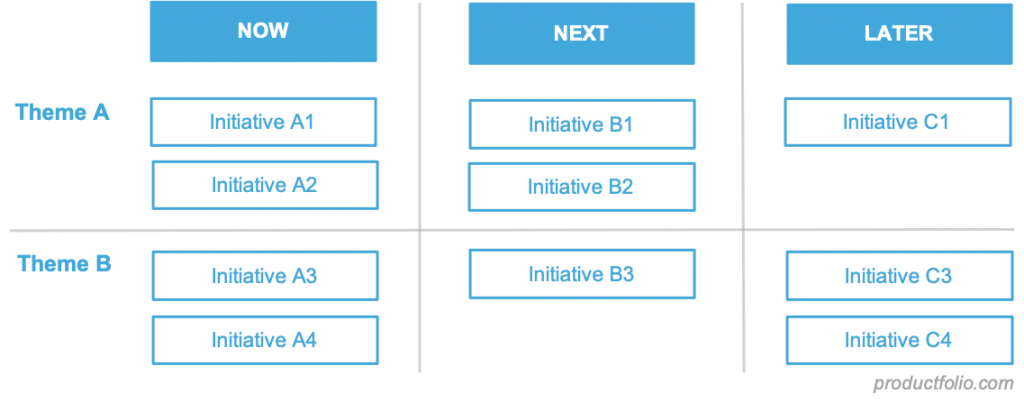What is a Kanban Roadmap?
Kanban roadmaps, also known as Agile Roadmaps, involve organizing cards relating to tasks into columns across boards. It presents quick insights into items and the stage you are in development at a glance. There are no dates or deadlines to abide by. Rather, major initiatives (or ‘outcomes’) are arranged into columns, typically with titles such as ‘Now’, ‘Next’, and ‘Later’.

A timeline roadmap, on the other hand, comes with deadlines. It stipulates timeframes within which tasks need to be completed. The document describes the initiatives you’re working on along with estimated delivery dates. It doesn’t provide contextual information on why you included items, in terms of goals.
The inclusion of deadlines is a major pitfall of timeline-based roadmaps. This makes them less ideal in Agile settings and makes Kanban roadmaps more appealing.
The Kanban technique removes too much specificity. It prevents unwanted pressure from stakeholders that comes with having dates and deadlines on your strategic document. You can change things as you consider necessary over time.
The main worry when using the Kanban approach is that you might change things too much.
When to Consider Using a Kanban Roadmap
Organizations practicing Agile and which have the flexibility to not drive according to dates can find this approach very useful because it does not box the team into delivering something by a certain date, which invariably leads to a more Waterfall and feature-centric approach, as the team seeks to defensively define what exactly can be delivered by that time. The problem with doing so, is that it doesn’t leave much flexibility for iterative discovery that can come in during development, to inform the team on a better or more informed path. This is especially important during the early stages of a product, in which product-market fit discovery, is of paramount importance.
Where Kanban Comes From
The Kanban methodology underlying this roadmap type was developed by Toyota for Just-in-Time (JIT) manufacturing in its factories. The term “Kanban” is Japanese for “visual signal,” “billboard,” or just “card.”
A major focus of Kanban is knowing the state of affairs at a glance. That’s what a roadmap based on the methodology also does. It allows you to group initiatives or activities into different groups and see how they fit into the big picture.
A Kanban roadmap has elements of both a backlog and a roadmap. Also known as a list-view roadmap, it shows what you are working on or intend to work on later. Items on these lists are typically color-coded to show what goal or theme that they relate to.
How Can a Kanban Roadmap Help?
Product managers can find a list-view roadmap very helpful when looking to organize development plans around tasks and make things run smoothly. At a glance, it gives you an idea of what’s going on without needing to first get and read through time-consuming reports. It lets you know easily and quickly what progress you’re making toward achieving your goals.
Monitoring may be easier with this type of roadmap. It makes it possible to easily keep a tab on all projects relating to a product. You might also be able to tell quickly who’s responsible for what. A Kanban roadmap is a good communication tool. For instance, it helps you to share the initiatives that you’re working on or hope to work on to stakeholders. This may reduce repetitive feature requests or having to answer questions from time to time on what features you’re working on.
With this kind of roadmap, you can present the right information to different stakeholders. It lets everyone know the progress being made but guides their actions differently. And, of course, a Kanban roadmap steers prioritization. It lets the product development team know what tasks should come first in light of your goals.


